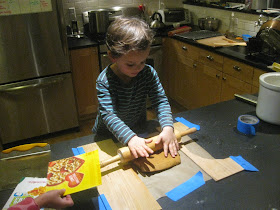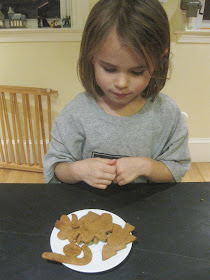We don't necessarily do gingerbread every year, but this year we did the full exercise and it was a good experience.
Becky arranged with some friends for their kids to come over one day and decorate houses. So altogether we needed 5 houses. She started by copying the plans out of Joy of Cooking onto stiff paper cut from a cereal box. Next, her and the kids premeasured the dry ingredients for 5 Joy sized batches of gingerbread.
I helped mix up the dough, mostly in the kitchen aid,
with a final kneading on the counter by hand.
On the final batch of dough, the kitchen aid gearbox completed its decline into complete non-functionality. That is the second mixer I've run through in ten years, which is incredibly frustrating. I spent $100 on spare parts to try to fix the last one, but was not successful.
These things are not cheap, and I don't use it more than a couple times a month if that. Anyone care to suggest a more durable stand mixer? Selecting a product targeted at the commercial market seems like a good idea, but the true commercial machines are surely way too big for me. I just want a reasonable sized home mixer that won't shred it's pot metal gears at the first sign of something tougher than whipped cream or fry its electronic controller within a few short years, is that too much to ask?
The only explanation I can think of is that these units are designed for sitting in the cabinet while people watch cooking shows on TV, rather than for actually mixing anything substantial. The thought of having to toss one of these in the landfill every couple years and buying a new one for many hundreds of dollars drives me crazy. I could conceivably do without, but it really does save a lot of time on the occasions when it is worth pulling out of the cupboard. I hate the fact that this is not the only case where it seems nearly impossible to buy something newly made that will actually be a quality product.
Maybe a vintage machine is the answer. Anything that is still around and functional from 40 or more years ago may have escaped designed obsolescence and cost stripping and proven its fitness for use.
Anyhow, we did get through the last batch, then let the dough sit for a few hours.
I dug up some 6mm baltic birch scraps from the basement to serve as thickness guides during rolling. These were blue taped to the counter over the top of a new parchment sheet for each piece of dough.
Each batch of dough was divided in two and rolled out. We only ended up using about 70% of each batch, but this extra dough made it easier since we didn't have to squeeze in each pattern piece or re-roll the scraps.
Over two evenings, we rolled and cut 10 each of roof pieces, sides, chimney sides, and shutters.
5 each of fronts, backs, chimney front, chimney back, and doors.
One set would be cooked while the next was being rolled and cut. After fully cooling, the pieces were consolidated and set aside.
The kids eagerly collected scraps and made them into their own set of cookies.
They enjoyed that at least as much as actually making the houses.
The next night, Becky whipped up some thick royal icing and we loaded it into parchment cones folded for use as adhesive.
A roughly 4mm circular piping tip was used to dispense the icing for assembly.
The sides of the houses went up easily,
but the roof planes and chimneys required holding in place for some minutes before the cookie pieces could wick enough moisture out of the icing to fix them in place.
Looks a little like a gingerbread housing developer came to town and built a whole row of cookie-cutter houses. Ha ha.
The houses dried out overnight, then were decorated by the five children the next day using a new batch of icing glue.
The kids don't believe us when we say they are not going to want to eat these after they sit around for a couple months.
They had a lot of fun making them though. Here they are as table dressing for a little holiday party we had with two other families and their kids. The pastry in the foreground is a big load of creampuffs Becky made up for the party. The awesome cookies in the middle were made by my mom, and we had just received them in the mail.






















I think the solution to your Kitchen Aid problem is finding an older one at an estate sale. I suspect some internet searching would give you the rough age you are looking for (was Kitchen Aid purchased by another company at some point? My FIL has his mother's (he's 81, you get the idea).
ReplyDeleteI love the gingerbread housing development but I love them more decorated.
I also have an older kitchen aid mixer. Hope it continues its long service. I really enjoyed the ginger bread house adventure. They look really great and such fun for the children. My daughter lets her boys nibble off the house a bit each day which means plucking a piece of candy off so it gets ragged in a hurry. Seems a shame to mess them up but they get to live for such a short time I guess it's the thing for them to enjoy them. Merry Christmas to all your family.
ReplyDeleteSJ is correct - the old ones were made by Hobart - the same company that makes commercial ones. They had all-metal innards. You can still find them, but rumour has it they are pricey. There are a couple of other brands that have serious fans, but I don't recall the names for certain. I *think* one is Kenwood, and there's another, maybe starts with a "Z"? The Chowhound forum under the equipment area should have more information. Maybe too much information :-)
ReplyDeleteI was just visiting my mother, who uses a 40-year-old (5qt? bowl lift type) for small jobs and a 20-qt countertop Hobart for big jobs (like her usual batches of frosting). She agrees that the newer non-commercial Kitchenaids are not so great.
ReplyDeleteThat said, one of the modern Kitchenaid gears is plastic and basically acts as a fuse, to protect the motor when the paddle gums up. It's supposed to be a simple repair job, but it sounds like you've tried this before.
(My 5qt Kitchenaid from 2003 works pretty well, but I don't really give it hard work).
- nathanw